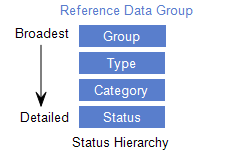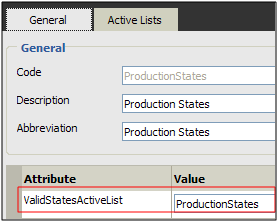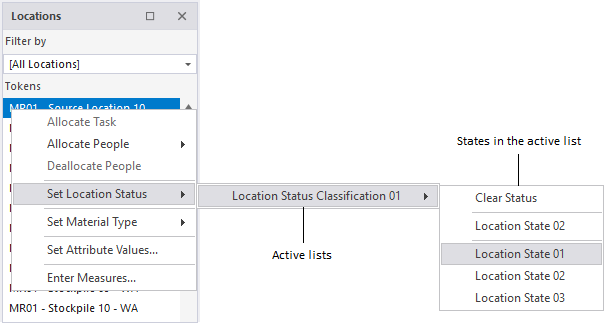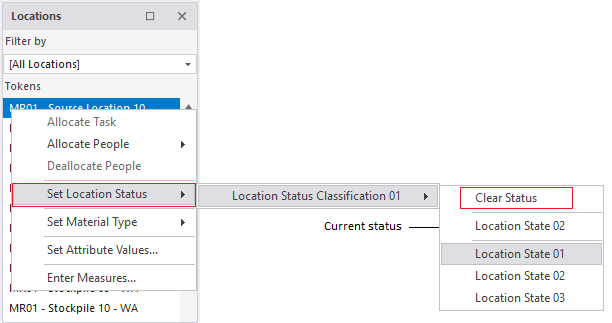Location states have a similar hierarchical configuration to that of equipment states. The hierarchy ranges from the broadest category to the more detailed category: from Group to Status. It is important to recognise and follow the hierarchy when defining location states.

The steps to create location states are:
-
Define individual location states by following the above hierarchy.
Locations are defined in Groups | Configuration Items | States | Location States. Define the LocationStatusGroup > LocationStatusType > LocationStatusCategory > LocationStatus. It is the detailed level, the LocationStatus tokens, that are assigned to locations. States such as Bogging, Charging and Drilled.
-
Define the groups of location states into active lists.
LocationStatus tokens are grouped into active lists to make assignment of location states more efficient. You may, for example, have an active list of Production states (Marked, Drilled, Blasted and Bogging) and Secondary states (To Bog, To Charge, To Drill and To Fire). Active lists are defined in Active Lists | Configuration Items | States | Location States.
-
Associate the location active lists into location tokens.
Once the location active lists are defined, they are associated with location states by defining tokens in the Location States | LocationStatusClassification reference data group. The attribute, ValidStatesActiveList defines the associated active list.
When defining any tokens in LocationStatusClassification do not define Code = Primary. For this reference group, Primary is a reserved word.

Location states are assigned in Data Acquisition:
-
On the Location pane in the data group of panes. Right-click and select Set Location Status.

- On a location status panel.
A location can have only one status from each of the groups of states at a time.
Secondary states
Secondary states are location primary states that have been grouped together into active lists. A location has a primary status: a secondary status provides extra information about the location. For example, you may have the following primary states that give some indication of the effectiveness of communications at a location. They are grouped together in an active list:
| Active List | Primary Status |
|---|---|
| Secondary Coms States | No Coms, Good Coms, Weak Coms |
LocA, for example, may be defined as follows:
- Primary status: Charging
- Secondary status: No Coms.
Secondary states are seen listed in a Location Status panel in Data Acquisition and on a Location Status report.
Clear status
When working in Data Acquisition or the Event Editor, a status that has been assigned to a location can be cleared. To achieve this in:
- Data Acquisition. Right-click on a location in the data group and select Set Location Status. Clear Status will be available for selection at the top of the list of location states. The current location status will be below the Clear Status option.
A location which has had its location status cleared will display a No Status location status value.

-
Event Editor. Click on the current location status and select [Clear] from the drop-down list of location states. This change of status for the location will be recorded with the original date-time for the event.
If the Null status (--?--) is defined as a location status in Reference Edit, the Description field of the Null token definition will replace the [Clear] value in the drop-down list of location states.